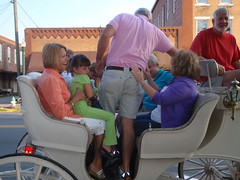Coming: Continue reading
Tag Archives: Hahira
Impervious cover increase, Lowndes County
Where’s all this change coming from and going to?


The dark green is labeled “Evergreen Forest” and decreased from 31.81% in 1991 to 26.47% in 2005. Meanwhile, the light pink labeled “Low Intensity Urban” went from 5.37% to 8.57%. Other changes include the red “High Intensity Urban” slice going from 1.15% to 1.98%. But the biggest change is piney woods being paved over for urban sprawl.
Could this have some effect on flooding?
-jsq
John S. Quarterman
Third Thursday, Hahira, GA
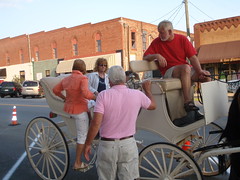
How many people can fit in a horse cart?
Don’t forget the children:
Let’s try to count them as they get out:
Cast: Walter Bird (driving), Sam (the horse), Nancy Evans Parr, Winfrey Murray Hendley, Wayne Bullard, Beverly Brown Underwood, Barbara Stratton, several children, and watching on the sidewalk, John S. Quarterman.
Third Thursday, 15 April 2010, Hahira, Lowndes County, Georgia.
Pictures by Gretchen Quarterman.
Comment on the Transportation Plan
 The Metropolitian Planning Organization (MPO)
invited people to a Public Open House last week
about prioritization of the 2035 Transportation Plan, so we went to the
RDC offices on W. Savannah Ave. and had a look.
You can see many of
the same materials online.
The MPO has a comment form you can fill out and mail to them.
There is also contact information on their web pages.
They are actively soliciting input.
The Metropolitian Planning Organization (MPO)
invited people to a Public Open House last week
about prioritization of the 2035 Transportation Plan, so we went to the
RDC offices on W. Savannah Ave. and had a look.
You can see many of
the same materials online.
The MPO has a comment form you can fill out and mail to them.
There is also contact information on their web pages.
They are actively soliciting input.
One thing I noticed was that along Cat Creek Road they are proposing several intersection upgrades (at Hambrick Road, New Bethel Road, and Radar Site Road) which look like they would funnel still more traffic through Hambrick Road to Moody AFB. Hambrick Road and Cat Creek Road are not highways. State highways 122 and 129 (Bemiss Road) make a nice fast route from Hahira to Moody. A few improvements at Walker’s Crossing (where 122 and 129 intersect) would seem much more appropriate. The MPO could request for the state to do that.
Widening of Old US41N is on the list again as a county project, this time as far as Union Road.
Several new roads are proposed throughout the city and county as well as widening of many roads with additional travel or turn lanes.
You can look over the list of projects and you’ll probably find ones to comment on.
DoJ Rejects Lowndes County Redistricting
 The Valdosta Daily Times seems to have
a reading comprehension problem:
The Valdosta Daily Times seems to have
a reading comprehension problem:
In denying the Lowndes County Commission the right to expand under the current proposed “superdistrict” plan, the DOJ stated in its opinion, “Our analysis of the evidence precludes a determination that the county has met its burden of showing that the proposed plan was not adopted, at least in part, with the purpose of making minority voters worse off.” In addition to stating that the plan was done deliberately to disenfranchise black voters, the letter of explanation that the DOJ sent to the county Tuesday regarding its denial of the petition states that the proposed plan was not in compliance with the Voting Rights Act regarding discrimination.Saying the county has not shown that it has not done something is not the same as saying the county deliberately did that thing.
The commission chairman seems to be forgetting his history:
Paulk said he is certain that the map met all of the criteria in the Voting Rights Act. The initiative was approved by the state’s General Assembly and voters approved the plan on Nov. 4, 2009.In denying the proposal, Paulk says the DOJ is denying the right of the people to vote on a plan of their choosing, noting that it passed overwhelmingly in the majority minority districts.
“We had a democracy when we drew those maps, not the socialist government we have now,” Paulk said.
The county districts currently in use were required in 1984 as part of a court settlement under that well-known socialist, Ronald Reagan.
That’s a good point about the plan passing overwhelmingly in the majority minority districts, but it also passed when nothing else was on the ballot for the county (everything else was for the various cities in the county), so few people outside Valdosta, Hahira, and Dasher voted on it. This problem was noted beforehand by state representative Ellis Black:
“My concern is about the inequity where it’s a special election in the unincorporated areas but it’s a regular city election,” Black said. “I’m concerned about the impact on the turn out as there will be a greater emphasis on city voters more so than the unincorporated voters.”The VDT quoted Ashley Paulk as saying he didn’t want to spend the money to hold a special election: “$40,880 minimum.” This from a county government that just spent $15 million for a bridge that few people use and $1.5 million to pave a road the majority of whose residents didn’t want paved. Is the will of the people in the unincorporated areas so unimportant? In any case, it looks like the county will now need to pay for developing another redistricting plan.
The VDT quotes Joe Pritchard, County Manager:
“We are satisfied that we did everything we possibly could to create a plan that met all of the criteria,” he said.If so, apparently all they could do was not enough. Also, the plan the county government proposed was not the only possible plan.
Back in 1997 a plan was proposed that would have put two commissioners in each of the two districts. The voters voted it down, and for that one the VDT wondered if the voters got it right, because the SPLOST tax was the big issue at the time, not commission expansion.
Another way would be to split the current districts lengthwise, creating two out of each of them. I don’t think that possibility was ever seriously entertained by the current commissioners. Why not is mysterious.
The DoJ was aware of the possibility of splitting at least the existing minority district, and said so:
Moreover, the evidence establishes that this retrogression was avoidable. Several alternatives exist that meet the county’s stated criteria and do not have a prohibited retrogressive effect. For example, it is possible to create an illustrative plan that follows the county’s 3-2 configuration, but which, unlike the county’s proposed plan, creates a second district in which census data show that the African American community would be able to elect a candidate of choice. The most recent data indicate that African Americans constitute 53 percent of the registered voters in this illustrative district. Although the county’s contention that the 2000 Census data understate this district’s current African American population percentage appears to be correct, it does not alter our conclusion, based on an analysis of voter registration data from October 2009, that the district would not afford black voters the ability to elect candidates of choice to office.That’s the paragraph in the DoJ letter immediately before the passage the VDT quoted. Neither the VDT nor the county government has chosen to put a copy of the DoJ letter on the web, but fortunately the DoJ did, so we don’t have to go by what we’re told to think; we can read the letter for ourselves.
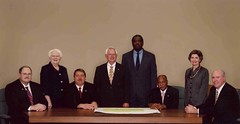 The VDT article about redistricting history neglects to mention that another plan was put to a vote around 1983 that would have expanded the county commission to 9 members, if I recall the number correctly from the VDT article of that period I saw in the county museum. That plan was only narrowly defeated by the people of the county. Perhaps a similar plan, better prepared and presented, might fare better today.
Thomas County, with about half the population of Lowndes County, has eight commissioners.
The VDT article about redistricting history neglects to mention that another plan was put to a vote around 1983 that would have expanded the county commission to 9 members, if I recall the number correctly from the VDT article of that period I saw in the county museum. That plan was only narrowly defeated by the people of the county. Perhaps a similar plan, better prepared and presented, might fare better today.
Thomas County, with about half the population of Lowndes County, has eight commissioners.
Current commissioners are aware of that mid-1980s plan, and at least one of them objects to it because it would have created a district entirely within Valdosta, which is already represented by the Valdosta City Council. This makes me wonder if all the voters in the current county commission districts who happen to live inside Valdosta (or Hahira, or Remerton, or Dasher, or Lake Park) don’t count? That would be ironic, since they’re the ones who just voted for the plan these same commissioners favored.
The county government also did everything it thought it possibly could to create a new county waste disposal plan last year, but external reality intervened in that case, too. The county couldn’t get bids for its plan at the minimum it required. This was just as well, since there were strenuous objections to the county’s plan, voiced by hundreds of people at the meetings the county held not to get early input, rather to tell the people what the county government had decided.
The incoming chairman, Ashley Paulk, came up with a new, simpler plan that addressed most of the objections of the old waste disposal plan and that’s the one now working fine. The current waste plan was sort of an emergency solution arrived at without much external input.
Here’s a chance for the new chairman to once again demonstrate the adaptability of the county government. Given that circumstances have repeatedly indicated that the county government’s solution to a problem isn’t necessarily correct just because the county government believes it is, perhaps this time a transparent process for citizen participation could be used so that the people and the DoJ could be convinced that a solution is correct.
Local Thanksgiving
-
 A growing local food community, anchored by
Jason DeLoach’s F.M. Guess Pecan Company of Valdosta,
the Packhouse Market of Hahira,
and of course
Jim Fiveash’s Food Store of Hahira.
Let’s not forget the Valdosta Farmer’s Market (1500 South Patterson Street)
and Farmer Brown’s Produce.
There’s even at least one local CSA (Community Supported Agriculture) starting up.
A growing local food community, anchored by
Jason DeLoach’s F.M. Guess Pecan Company of Valdosta,
the Packhouse Market of Hahira,
and of course
Jim Fiveash’s Food Store of Hahira.
Let’s not forget the Valdosta Farmer’s Market (1500 South Patterson Street)
and Farmer Brown’s Produce.
There’s even at least one local CSA (Community Supported Agriculture) starting up.
-

- Long distance transportation: Interstate 75 near I-10, numerous state highways, and an airport.
- Delta Airlines (I never thought I’d be writing this) for competitive airfares (except during holidays). And landing on one of the longest runways in the state.
- Railroads going in every direction carrying freight, which can also carry passengers whenever state and local people and governments get organized to do it.
-
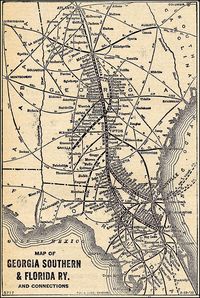 Businesses moving in to take advantage of the transportation;
working towards enough good jobs that young people don’t have to move away to find one.
Businesses moving in to take advantage of the transportation;
working towards enough good jobs that young people don’t have to move away to find one.
- County and city governments that are at least a little bit sceptical about exactly which businesses they encourage to move in.
- Moody Air Force Base, by far the biggest employer, bringing diversity to the community both in serving personnel and in later retirees.
- Two hospitals: South Georgia Medical Center and Smith Northview Hospital.
-
There’s even a
Valdosta Metropolitan Statistical Area (MSA)
including the counties of Lowndes, Brooks, Lanier, and Echols, with
a combined population of about 130,000.
This is enough people to try things without waiting for Atlanta or Washington to tell us what to do.

- Valdosta State University, one of two large regional campuses of the University of Georgia System, and one so active politically that it got its own voting precinct this year, the only college precinct in the state.
- Live election results during each election, on the Lowndes County website. It’s the only county in the state that does this!
- Georgia Military College, a liberal arts junior college.
- Valdosta Technical College, or whatever it’s being called since the state reorganized it.
-
 Thriving downtowns in
Valdosta and Hahira.
First Friday, Winterfest, Honeybee Festival:
those are doing more to attract attractive businesses than
any number of road projects.
Thriving downtowns in
Valdosta and Hahira.
First Friday, Winterfest, Honeybee Festival:
those are doing more to attract attractive businesses than
any number of road projects.
- Grand Bay Wildlife Management Area, preserving a little bit of the original ecosystem of the area; you know, pine trees, live oaks, wiregrass, pitcher plants, cypress swamps, alligators, great blue herons, and bobcats. Maybe you don’t. Go and see!
-
 Trees, for forestry, and
for themselves.
See Patterson Street (a little planning kept it from looking like Ashley Street), and the oldest longleaf pines in the county
are on the VSU campus; older than Valdosta.
There are even a few left elsewhere in the county.
Protecting forests is not just the right thing to do, it’s good business.
Trees, for forestry, and
for themselves.
See Patterson Street (a little planning kept it from looking like Ashley Street), and the oldest longleaf pines in the county
are on the VSU campus; older than Valdosta.
There are even a few left elsewhere in the county.
Protecting forests is not just the right thing to do, it’s good business.
- Rain, so trees and crops will grow.
-
 Sunshine, much more than
Germany, for example, so we can do
solar if we want to.
Sunshine, much more than
Germany, for example, so we can do
solar if we want to.
-
Winning sports teams in Lowndes County and Valdosta high schools and VSU
caused ESPN to name Valdosta
TitleTown.
Maybe that winning attitude can carry over to
improving academics.

-
Theatre at the
Dosta, VSU, and the high schools.
If theatre was a sport, we’d be winning that, too!
Dites-moi
Pourquoi
La vie est belle,
Dies-moi
Pourquoi
La vie est gai?Tell me why
The sky
is filled with music,
Tell me why
We fly
on clouds above?
Why stop with what we’ve got? Why not play up our advantages of transportation, natural environment, local culture, etc., and attract jobs for young people and make the place even better for everybody?
Hahira Discovers Planning Overlays
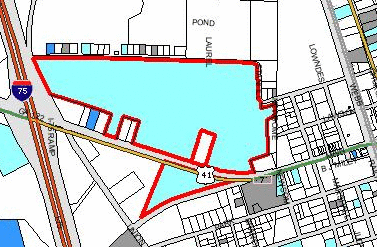
The new development regulations were proposed in light of plans for the Gateway to Hahira project, which include a Harveys Supermarket. While the developer for the project has promised that its design will match the integrity of the small town, downtown atmosphere, there are no regulatory provisions in place to ensure this.Or they could just trust the developers of a project bigger than downtown Hahira that it will preserve the Mayberry character of Hahira. The Lowndes County Real Estate database shows that Hahira Gateway LLC owns much more land north of 122 than it does in the angle south of 122.“During a previous work session, council members learned that there could be design overlay guidelines adopted along that corridor,” Sumner said. “Therefore, regulations are being developed and will go to the planning commission before they are presented to the council for consideration. This moratorium (or hold) just ensures that we have time to adopt the guidelines at the November meeting before anything is done along the gateway corridor.”
Biggest polluters in Lowndes County
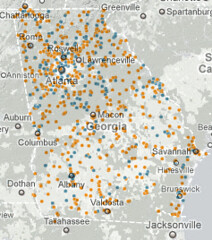 The New York Times provides an interactive map of water polluters.
According to that map, derived from Environmental Protection Agency (E.P.A.) data mostly from 2004 through 2007,
the biggest offenders in Lowndes County by number of violations are:
The New York Times provides an interactive map of water polluters.
According to that map, derived from Environmental Protection Agency (E.P.A.) data mostly from 2004 through 2007,
the biggest offenders in Lowndes County by number of violations are:
62 Moody Air Force BaseThese are all way ahead of Hahira’s notorious sewer system (supposed to be fixed now) and Valdosta’s Mud Creek WPCP (supposed to be being fixed now), both with 11 violations. Moody is not surprising, due to sheer size, although disappointing. The one that surprises me is the Boys Ranch.
42 Arizona Chemical Company
37 Georgia Sheriffs’ Boys Ranch
Of course, number of violations is just one measure, but it is an interesting one.
VSU-TV Rebroadcasts of AAUW Forum
 According to email from Walter Rollenhagen:
According to email from Walter Rollenhagen:
The Lowndes Co. Political Forum, or as we label it, VOTE 2009, will air on VSU-TV cable channel 20:
Sunday, Oct. 4th at Noon
Saturday, Oct. 10th at Noon and Midnight
Saturday, Oct. 17th at Noon and Midnight
Sunday, Oct. 18th at Noon
Saturday, Oct. 24th at Noon and Midnight
Sunday, Oct. 25th at Noon
Saturday, Oct. 31st at Noon and Midnight
Sunday, Nov. 1st at Noon
Lowndes County Political Forum, AAUW, 15 Sep 2009
On Sept 15, residents of Lowndes County gathered inside VSU’s Whitehead Auditorium for a political forum concerning the upcoming 2009 General Municipal Elections. It was the competing Mayberrys, Hahira and Dasher, in the shadow of the big city of Valdosta with its council and school board. The 100 or so people who watched learned about the candidates. You can too, by watching the videos of each speaker provided by LAKE on YouTube. Perhaps VSU can also be encouraged to release online the videos it took, which are probably of higher quality.
Update: VSU TV rebroadcast schedule for this forum.
Perhaps VSU can also be encouraged to release online the videos it took, which are probably of higher quality.
The event was sponsored by the American Association of University Women (AAUW) and moderated by Jim Peterson, chair of the Political Science Department at VSU. Before the forum began, the audience was provided note cards and encouraged to write questions for forum participants. A three person committee then decided which four questions that would be asked on stage for each set of candidates.
Valdosta City Council District 2
The forum began with the five candidates competing to be the newest councilman of Valdosta’s 2nd district. Willie T. Head, the incumbent, is not running, but five other people other are: David G. DeMersseman, David L. Dempsey, Rodney R. Flucas, Deidra A. White, and Dr. L. W. Williams.
(All the other LAKE videos of this AAUW forum are also available online.)
The first question of the night concerned annexing land neighboring Valdosta and if candidates believed it to be a good idea or not. Continue reading

